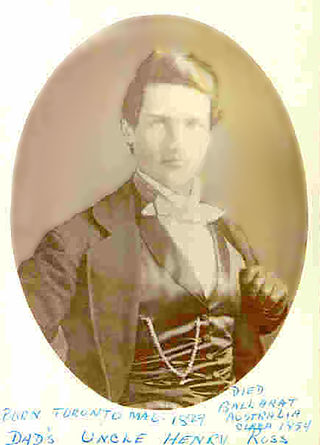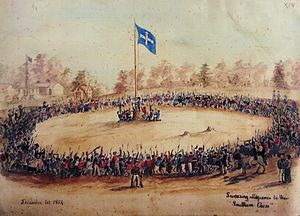
The Eureka Rebellion was a series of events involving gold miners who revolted against the British administration of the colony of Victoria, Australia during the Victorian gold rush. It culminated in the Battle of the Eureka Stockade, which took place on 3 December 1854 at Ballarat between the rebels and the colonial forces of Australia. The fighting resulted in an official total of 27 deaths and many injuries, the majority of casualties being rebels. There was a preceding period beginning in 1851 of peaceful demonstrations and civil disobedience on the Victorian goldfields. The miners had various grievances, chiefly the cost of mining permits and the officious way the system was enforced.

The Victorian gold rush was a period in the history of Victoria, Australia, approximately between 1851 and the late 1860s. It led to a period of extreme prosperity for the Australian colony and an influx of population growth and financial capital for Melbourne, which was dubbed "Marvellous Melbourne" as a result of the procurement of wealth.

The Eureka Flag was flown at the Battle of the Eureka Stockade, which took place on 3 December 1854 at Ballarat in Victoria, Australia. It was the culmination of the 1851 to 1854 Eureka Rebellion on the Victorian goldfields. Gold miners protested the cost of mining permits, the officious way the colonial authorities enforced the system, and other grievances. An estimated crowd of over 10,000 demonstrators swore allegiance to the flag as a symbol of defiance at Bakery Hill on 29 November 1854. It was then flown over the Eureka Stockade during the battle that resulted in at least 27 deaths. Around 120 miners were arrested, and many others were badly wounded, including five soldiers.

Peter Fintan Lalor was an Irish-Australian rebel and, later, politician, who rose to fame for his leading role in the Eureka Rebellion, an event identified with the "birth of democracy" in Australia.

John Basson Humffray was a leading advocate in the movement of miner reform process in the British colony of Victoria, and later a member of parliament.

Henry Ross was a Canadian-Australian gold miner who died in the Eureka Rebellion at the Ballarat gold fields in the British Colony of Victoria, now the state of Victoria in Australia. Ross is particularly remembered for his part in the creation of the rebel miners' flag, since named the Eureka Flag.

Henry Erle Seekamp was a journalist, owner and editor of the Ballarat Times during the 1854 Eureka Rebellion in Victoria, Australia. The newspaper was fiercely pro-miner, and he was responsible for a series of articles and several editorials that supported the Ballarat Reform League while condemning the government and police harassment of the diggers. After the Rebellion was put down, he was charged, found guilty of seditious libel, and imprisoned, becoming the only participant to receive gaol time.

Eureka Stockade is a 1949 British film of the story surrounding Irish-Australian rebel and politician Peter Lalor and the gold miners' rebellion of 1854 at the Eureka Stockade in Ballarat, Victoria, in the Australian Western genre.
The following lists events that happened during 1854 in Australia.

The Ballarat Reform League came into being in October 1853 and was officially constituted on 11 November 1854 at a mass meeting of miners in Ballarat, Victoria to protest against the Victorian government's mining policy and administration of the goldfields.

John King (1830-1881) was a police constable at the Battle of the Eureka Stockade who was responsible for seizing the rebel war flag.

Bakery Hill is an inner city suburb of Ballarat in Victoria, Australia. It is the smallest suburb in the city of Ballarat in terms of both area and population, which at the 2021 census was just 180 people. The area is a mix of residential and commercial, as it has been since it came into existence at the beginning of the gold rush. In the present time it is mainly known for its restaurants and pubs, as well as fast food. The suburb boundaries are that of Mair, East, Barkly, Steinfield and Peel Streets.

The Battle of the Eureka Stockade was fought in Ballarat, Victoria, Australia on 3 December 1854, between gold miners and the colonial forces of Australia. It was the culmination of the 1851–1854 Eureka Rebellion during the Victorian gold rush. The fighting resulted in at least 27 deaths and many injuries, the majority of casualties being rebels. The miners had various grievances, chiefly the cost of mining permits and the officious way the system was enforced.

The Eureka Jack Mystery relates to the reported flying of a second battle flag by the rebels during the Eureka Rebellion in 1854.
The following bibliography includes notable sources concerning the Eureka Rebellion. This article is currently being expanded and revised.

The Eureka Rebellion, an 1854 gold miner's revolt in Victoria, Australia, has been the inspiration for numerous novels, poems, films, songs, plays and artworks. Much of Eureka folklore relies heavily on Raffaello Carboni's 1855 book, The Eureka Stockade, which is the first and only comprehensive eyewitness account of the uprising. The poet Henry Lawson wrote about Eureka, as have many novelists.

The following is a comprehensive timeline of the Eureka Rebellion.

The 1855 Victorian high treason trials took place between 22 February – 27 March in the aftermath of the Battle of the Eureka Stockade. The Goldfields Commission recommended a general amnesty for all on the runs from the fallen Eureka Stockade. Instead, thirteen of the rebels detained were eventually indicted for high treason. The juries all returned a verdict of not guilty by a jury, and the indictment against Thomas Dignum was withdrawn. On 23 January, the trial of Ballarat Times editor Henry Seekamp resulted in a finding of guilt for seditious libel, and a month later, he was sentenced to a term of imprisonment of six months. The trials have been described as farcical, and the colonial secretary would rebuke Governor Sir Charles Hotham over prosecuting the Eureka rebels for the lofty offence of high treason.

The Eureka Stockade was a crude battlement built in 1854 by rebel gold miners at Ballarat, Australia during the Eureka Rebellion. It stood from 30 November until the Battle of the Eureka Stockade on 3 December. The exact dimensions and location of the stockade are a matter of debate among scholars. There are various contemporary representations of the Eureka Stockade, including the 1855 Victorian high treason trials map and Eureka Slaughter by Charles Doudiet.








